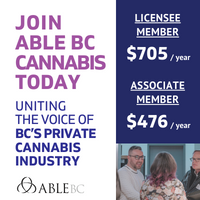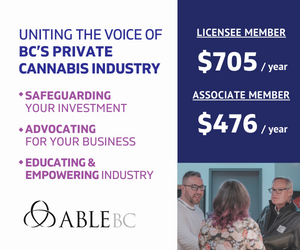
After decades of legal medical cannabis, and recent adult-use legalization, we are still nowhere near medical cannabis reform in Canada.
But hope is not lost.
Industry experts say that now is a critical time and advocacy efforts need to be persistent and patient. There have been many advances since legalization but the fight is far from over. It isn’t enough to maintain the two separate sales streams – patients need medical cannabis reform.
Ahead of the mandated Health Canada review of the Cannabis Act, continued advocacy and leadership is more important than ever.
“If you are apathetic to the medical side, or if you are dismissive to it, I think it lends itself more easily to be blended with the recreational. I don’t think that it’s an active plan to blend the two streams. But I think that apathy will lead us towards amalgamation if we’re not careful.”
Cameron Bishop, Diplomat Consulting
Celebrate the wins
“Recreational stores did increase points of access for patients,” said Cameron Bishop, policy expert and Senior Vice President of Diplomat Consulting. “If they had barriers to the medical mail delivery system, they could now go to a retail store.”
Increased accessibility and the beginnings of normalization opened the door for people to engage in the cannabis conversation in an entirely new way. It shifted the narrative around cannabis from stigma to curiosity according to Ashleigh Brown, Founder and CEO of SheCann, a medical cannabis education and advocacy group.
“Adult-use legalization was intended to empower Canadians,” shares Brown. “The recreational stream has been a stepping stone for those who may have been discouraged by their physicians or felt intimidated by the ACMPR.”
The work isn’t done
Price is still a major barrier to access for many Canadians. Two years after legalization and a majority of insurance companies and government support programs do not cover physician-authorized cannabis products. Many cannabis patients struggle to afford the amount of product their physician recommends.
I have never encountered a situation when discussing medical cannabis access in Canada that didn’t involve the topic of affordability
Ashleigh Brown, SheCann
“I have never encountered a situation when discussing medical cannabis access in Canada that didn’t involve the topic of affordability,” says Brown. “Until medical cannabis is zero-rated and covered under all public and private insurance plans, it is too expensive – no matter what the price.”
“In order to relieve the financial strain on patients, multi-organizational action is needed,” says Diplomat Consulting’s Bishop. “The conversations needed to achieve this aren’t limited to Health Canada.”
According to Bishop, there is a general apathy towards the medical stream and it limits patient access and industry innovation. Regulating and taxing adult-use and medical products the same way does a disservice to patients and medicalization. Limited clinical research, participation of pharmacies and educational institutions, and physician support fuel a self-fulfilling cycle.
“A lack of an economic strategy for this sector has held it back, whether it’s medical or recreational. The excise tax on medical products is problematic too, it’s a massive disincentive to patients. A lot of licensed producers eat the excise tax to not pass it on to the patients. It not only hurts the industry; it also hurts the broader medicalization of the field.”
Pharmaceutical consultation and distribution
“Pharmacies can and should play a role in this distribution system so that people can have equal access to their medicine and professional guidance on dosing, drug interactions and titration,” says Brown. Not having access to medical cannabis from a storefront really puts many people at a disadvantage (and assumes said people have a computer, a credit card, and a home address that is accessible to a major carrier like Canada Post or Purolator).
“Budtenders are not medical professionals. If you are going to medicalize a space, it stands to reason that you also have to make it available in places like pharmacies,” speculates Bishop. “There could be a facilitation of pharmaceutical access, but it would take a willingness on the part of the provinces to do that.”
Bishop explains that if any given province was inclined, they could allow pharmacies to dispense medical cannabis and set the parameters around how and what is sold. This isn’t a dirty little secret, Health Canada knows 69(3) of the Cannabis Act allows provinces to make their own rules around distribution.
“There is a section of the Cannabis Act that allows for provinces and territories to determine the retail environment of cannabis,” said Bishop. “Provided the conditions in 69(3) are met, there is nothing in the legislation precluding them from expanding their distribution and retail framework to include access to medical cannabis in pharmacies.”
Review Doesn’t Mean Reform
From a policy standpoint, the upcoming Health Canada review of the Cannabis Act is a mandatory one – it doesn’t mean anything will necessarily change. “It’s a consultation, there is no promise of reform,” explains Bishop. “We also don’t know the scope of the consultations; they could be incredibly broad or narrow in on specific areas.”
SheCann’s Brown says she would like to see key issues addressed in the review – such as the removal of the excise tax and separate THC limits for medical users. However, she knows this wish list comes with continued education and extensive consultation – and a little patience.
Patients need to engage, connect, and push back with members of Parliament to get cannabis back on the agenda
ASHLEIGH BROWN, SHECANN
“I think it’s really important for us as patients and advocates to remember that this is the first of two reviews,” says Brown. “So this is kind of like a dress rehearsal for regulatory reform for medical cannabis.”
“Health Canada will be conducting a full review of the medical cannabis system in October 2023. I believe that we can create a better, more accessible system in the next few years,” shares Brown. “I may not have all the answers, but I do have all the optimism.”
There is still a lot of that stigma that influences how the government thinks about, and approaches, both adult-use and medical cannabis. While Bishop also thinks change is coming – his timeline is a little more cynical. This is where persistent patients, stakeholders, and advocates make a difference.
“If you are apathetic to the medical side, or if you are dismissive to it, I think it lends itself more easily to be blended with the recreational. I don’t think that it’s an active plan to blend the two streams. But I think that apathy will lead us towards amalgamation if we’re not careful.”
Think Globally – Act Locally
Major strides have undoubtedly been made in the last few years and the journey isn’t over yet. “People have been fighting for years,” says Bishop. “Change takes time and those who advocate for medical cannabis know it is a fight worth having.”
In order to create changes, advocacy efforts need to be focused on legislative change. “Patients need to engage, connect, and push back with members of Parliament to get cannabis back on the agenda,” says Bishop. He explains that pressure from patients and stakeholders would create incentive for issues like removal of the excise tax.
“Companies need to get involved too and tell their MPs that they aren’t going to keep absorbing these costs,” says Bishop. “The industry can vote with their dollars – stop donating to parties that don’t carry your message. If you’re a medical producer and they aren’t helping from a tax perspective – withhold your support, withhold your votes, but don’t give up the fight.”













